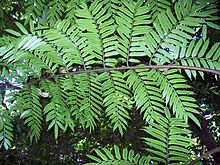Marattiaceae
| Marattiaceae | ||||||||||||
|---|---|---|---|---|---|---|---|---|---|---|---|---|

Boat fern ( Angiopteris evecta ) |
||||||||||||
| Systematics | ||||||||||||
|
||||||||||||
| Scientific name of the class | ||||||||||||
| Marattiopsida | ||||||||||||
| Doweld | ||||||||||||
| Scientific name of the order | ||||||||||||
| Marattiales | ||||||||||||
| link | ||||||||||||
| Scientific name of the family | ||||||||||||
| Marattiaceae | ||||||||||||
| Kaulf. |
The Marattiaceae are a family of ferns . It is the only recent family within the order Marattiales and also forms the only recent family within the class Marattiopsida .
features
Roots and trunk
The recent species have large fleshy roots with a polyarchic (multi-rayed) xylem . The root hairs are multicellular. All organs are traversed by mucous canals. The rhizome is fleshy, short, erect or creeping, and has a polycyclic dictyostele . Other species have a short, bulbous trunk ( Angiopteris ). The young tribe has a protostele. Later it divides into a polystele, whereby the trunk increases in thickness. The fern trunk is therefore conical with the tip pointing downwards, and there is no secondary growth in thickness. Some recent forms have a siphonostele. The stem base is reinforced by the leaf feet , the leaf bases that remain after the leaf falls . Advent roots also contribute to stability.
Leaves and sporangia

A bundle of leaf fronds sits on the trunk. These are a few meters long and usually one or more pinnate. Some species, such as Danaea simplicifolia , have undivided leaves. In youth, the leaves are rolled and have at the base a large, fleshy Nebenblatt pair. The leaves are fleshy. Joints ( pulvini ) are located on the leaf as well as on the feathers . The leaf nerve is open. The petiole xylem is polycyclic. Trunk and leaf blades are covered with scales.
The sporangia are located on the underside of the leaf. So there is no separation into sterile and fertile leaves, they are sporotrophophylls . The sporangia are isospore. In some genera they are laterally fused to form synangia: these are capsule-like, fanned out and open when ripe. In others, the sporangia are free or grouped in heaps ( sori ). The sporangia wall consists of more than one cell layer (eusporangiat) and has no annulus. Each sporangium forms 1,000 to 7,000 spores.
Gametophyte
The prothallia are long-lived (up to several years) and have endophytic mycorrhizal fungi . In contrast to the Psilotopsida , for example , they are green and autotrophic . The thallus is multilayered, similar to liver moss and developed flat from the start. The antheridia and archegonia sit on the underside and are sunken.
The basic chromosome number is x = 40 (rarely 39).
Occurrence
The Marattiaceae grow in tropical forests. Marattia is pantropical, Angiopteris and Christensenia are native to East and Southeast Asia, Danaea in South America. They achieve the greatest biodiversity in the Malay region. They grow terrestrially, rarely on rock.
paleontology
The oldest fossils of the Marattiales are known from the Carboniferous . They were particularly rich in species in Rotliegend . They formed trees, the trunks of which were covered with roots and were up to 10 meters high. At that time they dominated the leptosporangiate ferns that are predominant today . Megaphyton was characterized by fronds arranged in two lines.
etymology
The name Marattia refers to the Italian clergyman and botanist Giovanni Francesco Maratti (1723–1777), who was a professor in Rome.
Systematics
There are four recent genera with around 150 species. The group is monophyletic.
-
Angiopteris
Hoffm. , with - depending on the author - one or up to about 100 species, including:
- Boat fern ( Angiopteris evecta (G. Forst.) Hoffm. ), Which occurs from Madagascar to tropical Asia and the western Pacific.
- Christensenia Maxon , with two species in Assam and in western Malesia
- Danaea Sm. , With about 16–30 species in America
-
Marattia Sw. , with about 6–60 species in the tropics and in the temperate zone of the southern hemisphere, including:
- Marattia alata Sw. , Home: West Indies, tropical South America
- Marattia cicutifolia Kaulf. , Home: Southern Brazil
- Marattia fraxinea J. Sm. , Home: tropical and southern Africa, Madagascar, Mauritius
Some authors have a fifth genus Archangiopteris Christ & Giesenh. , but this is usually put to Angiopteris . Danaea and Christensenia are sometimes placed in their own families.
Sources and further information
literature
- Peter Sitte , Elmar Weiler , Joachim W. Kadereit , Andreas Bresinsky , Christian Körner : Textbook of botany for universities . Founded by Eduard Strasburger . 35th edition. Spektrum Akademischer Verlag, Heidelberg 2002, ISBN 3-8274-1010-X .
- Alan R. Smith, Kathleen M. Pryer, Eric Schuettpelz, Petra Korall, Harald Schneider, Paul G. Wolf: A classification for extant ferns. In: Taxon. Volume 55, No. 3, 2006, ISSN 0040-0262 , pp. 705-731, abstract, PDF file .
- Walter Zimmermann : Phylogeny of the plants. An overview of facts and problems. 2nd, completely revised edition. Gustav Fischer, Stuttgart 1959, pp. 289-295.
- David J. Mabberley: The Plant Book. A portable dictionary of the higher plants. Cambridge University Press, Cambridge et al. 1987, ISBN 0-521-34060-8 .
- Walter Erhardt , Erich Götz, Nils Bödeker, Siegmund Seybold : The great pikeperch. Encyclopedia of Plant Names. Volume 2: Types and Varieties. Eugen Ulmer, Stuttgart 2008, ISBN 978-3-8001-5406-7 .
Individual evidence
- ↑ Helmut Genaust: Etymological dictionary of botanical plant names . 3. Edition. Nikol-Verlag (licensed edition), Hamburg 2012, ISBN 978-3-86820-149-9 , p. 367 .
- ↑ Smith et al .: A classification for extant ferns , 2006.
- ^ A b Marattiaceae in the Germplasm Resources Information Network (GRIN), USDA , ARS , National Genetic Resources Program. National Germplasm Resources Laboratory, Beltsville, Maryland. Retrieved February 20, 2019.

